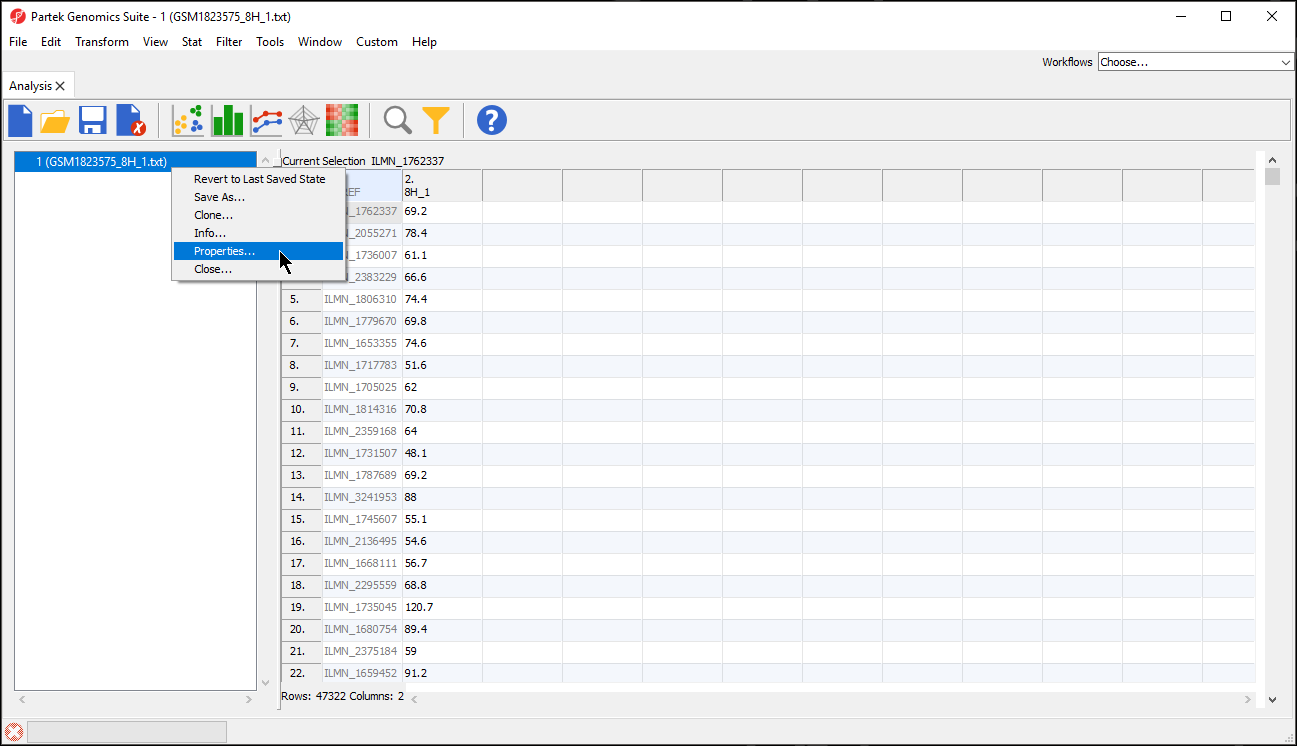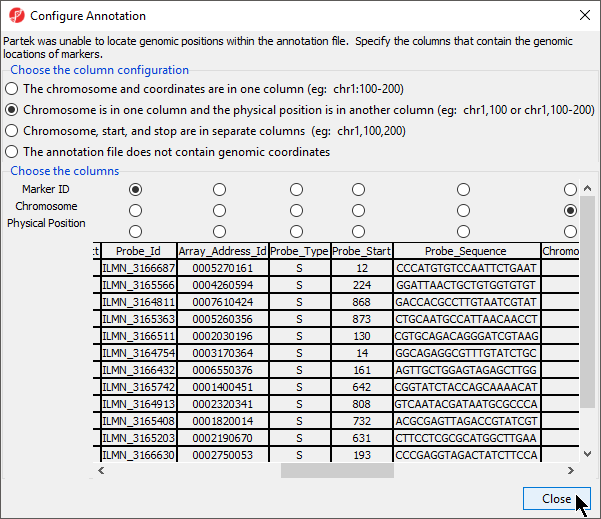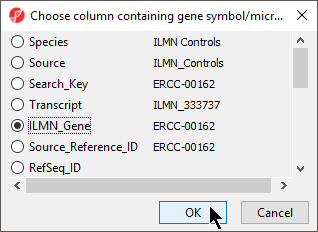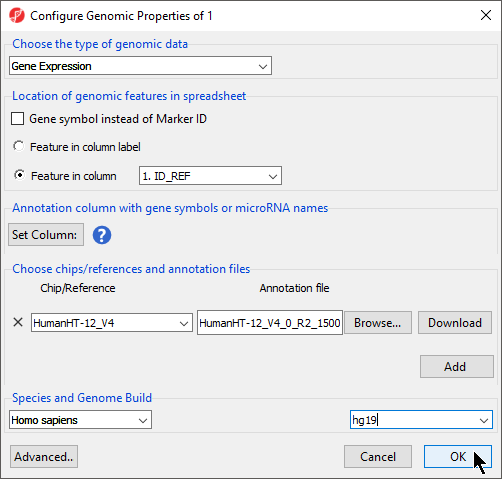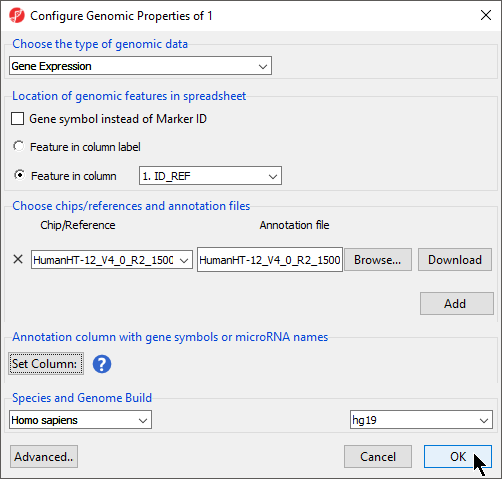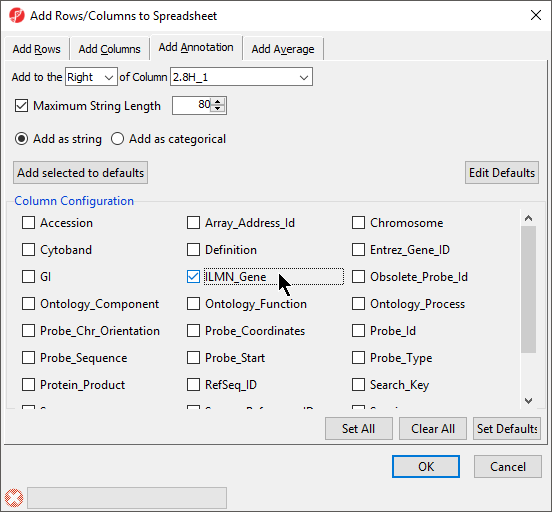Page History
...
For Partek® Genomics Suite® to recognize an annotation spreadsheet, it must meet several requirements. First, there must be a column header row in the annotation file. Second, there must be a column in the annotation file that matches the probe identifiers in your data spreadsheet. Third, any text field above the column header row must start with #. Fourth, the text fields must be tab or comma delimited.
...
- Open the annotation file with a text editor such as Notepad++/WordPad/TextEdit (Microsoft Excel is not recommended to edit text files, for instance when used default settings, it converts gene names to dates and floating-point numbers)
Microsoft Excel is not recommended for viewing text files because on default settings it converts some gene names to dates and others to floating-point numbers
- Verify that a column in the annotation file matches the probe identifiers identifier in your data spreadsheet, e.g probe ID, the identifier must be unique to each row
- Remove the text before the first column header (Figure 1) or add # to each text box and save the annotation file
...
- box
- Save the annotation file as a .txt file
| Numbered figure captions | ||||
|---|---|---|---|---|
| ||||
- Right-click the spreadsheet you want to annotate in the spreadsheet tree panelSelect , select Properties from the pop-up menu (Figure 2) or select Properties from the File menu on the main toolbar
| Numbered figure captions | ||||
|---|---|---|---|---|
| ||||
...
The Configure Genomic Properties dialog will now open.
- Select the appropriate option for Choose the type of genomic data; here we have chosen Gene
...
- Expression (Figure 4).
| Numbered figure captions | ||||
|---|---|---|---|---|
| ||||
- Select the appropriate options for Location of genomic features in spreadsheet
Selecting Gene Symbol instead of Marker ID allows biological interpretation tasks like GO Enrichment or Pathway Enrichment to be performed without an annotation file because the gene symbol can be used to look up the gene set or pathway database.
Location of genomic features in spreadsheet allows you to specify whether genomic features (e.g. genes, miRNAs, probes, SNPs, CpGs etc) are represented by columns or rows. For Feature in column label, each feature is on a column, each row is a sample. For Feature in column, each feature is on a row and the feature ID for each feature is located in the column chosen with the drop-down menu.
Choose chips/reference and annotation files allows you to specify an annotation file to associate with the spreadsheet.
- Select Browse... from Choose chips/references and annotation files
- Select your annotation spreadsheet file using the file selection interface
...
The Choose the columns section displays the annotation file spreadsheet with options to choose which columns are the Marker ID,Chromosome, and Physical Position (Figure 34).
- Select the column that matches the feature IDs in your data spreadsheet for Marker ID; we have chosen Probe_Id for Marker ID.
...
- Select Close to return to the Configure Genomic Properties
An index file for the genomic location data of the annotation file is generated in the same folder as the annotation file; it has the same file name as the annotation file, but the file extension .idx. If you need to re-configure the genomic location field in the annotation file, first manually delete the .idx file and re-do the above steps to generate a new index file for the annotation file.
| Numbered figure captions | ||||
|---|---|---|---|---|
| ||||
The Chip/Reference text field will be populated with the annotation file name. You can edit this text field this if you wish.
For the Annotation column with gene symbols or miRNA names section, if Gene symbol instead of Marker ID is selected, this field is used automatically populated with the gene symbol column; however, if it is not selected, you will need to manually specify the column in the annotation file that corresponds with gene symbols or miRNA names.
- Select Set Column:
Select the appropriate column from the dialog; here we have selected ILMN_gene (Figure 5)
Select OK
| Numbered figure captions | ||||
|---|---|---|---|---|
| ||||
Species and gene symbol information is required for biological interpretation analysis.
- Select the correct species and genome build from the Species and Genome Build section of the dialogthe drop-down menus; we have chosen Homo sapiens and hg19 hg19 (Figure 46)
- Select OK apply the annotation file to your data spreadsheet
| Numbered figure captions | ||||
|---|---|---|---|---|
| ||||
- Select OK apply the annotation file to your data spreadsheet
To verify that the annotation has been added, we can try to add annotation information to the spreadsheet when the feature are on rows in the spreadsheet.
- Right-click on a column in the annotated data file spreadsheet
- Select Insert Annotation from the pop-up menu (Figure 5)
...
| Numbered figure captions | ||||
|---|---|---|---|---|
| ||||
Building an Annotation File
Annotation files for most commercial arrays are available from the chip manufacturer. If you have a custom chip or want to use a customized annotation file, you can create an annotation file that will allow you to add annotations to your data spreadsheet and invoke a Probe Set HTML reportfeatures (e.g. probe IDs) when the features are represented by rows on the spreadsheet. Your annotation file must meet the following criteria:
...
To invoke a genome view of your data, your annotation file must also have one or more columns that contain the genomic location in a format that Partek Genomics Suite can recognize. The annotation file must also contain a column that has the chromosome and base pair location (start and stop or physical position). Cytoband and/or strand can also be included.
The table below provides possible column labels, a description of the format for that field, and an example.
Note: In this table, the examples are for a gene on the top strand of chromosome 3; on the p arm in cytoband 14.2 starting at 69,871,322 base pairs and ending at 70,100,176
| Column label | Description of format | Example |
|---|---|---|
| chromosome | a chromosome label | 3 |
| start | an integer, the start position (in base pairs) of the feature | 69871322 |
| stop | an integer, the stop position (in base pairs) of the feature | 70100176 |
| genomic_coordinates | chromosome:start-stop | 3:69871322-70100176 |
| strand | + for top, - for bottom | + |
| physical position | an integer, the position (in base pairs) of the feature | 70100176 |
...

